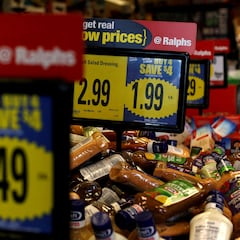Why do businesses keep raising their prices? This could be the main reason
While price growth has slowed across most key commodity sectors, prices are still rising, further cutting into the purchasing power of households across the country.


In December 2022, the average worker in the United States was making—in real terms—around two percent more than they were in early 2019. Corporations, on the other hand, saw their “income” or profits increase by fifty-five percent over the same period. These gains in profits have come as households in the US and around the world grapple with high inflation. But now that many of the supply chain constraints caused by the covid-19 pandemic have been resolved and energy prices are falling, why do prices keep rising?
One answer that has growing recognition among researchers is corporate greed and the desire to rake in as much profit as possible without any attention paid to the possible consequences. Some might argue that the profit motive is a fundamental component of capitalism, and thus it cannot explain why all of a sudden, corporations are exploiting their power to extract higher profits. What this analysis overlooks is that firms, like consumers, are not static; they adjust their behavior in accordance with the dynamism of market conditions. Two researchers at the University of Massachusetts Amherst explained how the economic crisis caused by the pandemic gave firms cover to raise prices but that sector-wide coordination remained critical if profits were to increase in the long term. “Bottlenecks can create temporary monopoly power which can even render it safe to hike prices not only to protect but to increase profits,” argue the authors, adding that “publicly reported supply chain bottlenecks and cost shocks can also serve to create legitimacy for price hikes.” Consumers, many of whom were flushed with cash payments in the early stage of the pandemic, were inundated with talk of supply chain issues and accepted that they would have to pay higher prices. The problem facing the economy now is that as incomes have fallen and supply chain constraints have more or less been resolved, firms are not lowering prices.
Market consolidation, or monopolistic competition, comes with great risks, and in the US, many commodity markets, particularly those that consumers are extremely dependent on, like food and energy, are highly consolidated. According to Open Markets, an anti-trust consumer advocacy organization, “the top four corporations control more than 60% of the U.S. market for pork, coffee, cookies, and bread, [..] more than 70% of the U.S. market for yogurt, beer, and soybean seeds [... and] more than 80% of the market for beef processing, corn seed, soybean processing, baby food, pasta, cereal, soda, and more.” Anti-trust experts argue that this level of corporate consolidation is a risk to national security because when firms are able to reach this level of market control they “are more likely to abuse their market power and collude on their pricing decisions either through an explicit price-fixing conspiracy or more tacit practices, such as moving as a group or avoiding competition without an explicit agreement to do so.” In the case of food commodities, consolidation predates the pandemic, but it was the effects of the health crisis on production that allowed these firms to exploit their power.
In January, Federal Reserve Vice Chair Lael Brainard spoke publicly about how “final prices” (i.e., those paid by consumers) had “risen by more than the increases in input prices.” In other words, the Federal Reserve noticed a gap between the markups paid by consumers and the increases in costs faced by firms that motivated those markups. Where did those additional funds go? Profits. Any additional revenue generated by a firm that is not subtracted from its costs is, by definition, profit. The firm may not be able to keep all of that additional revenue since the profits may still be subject to taxation, but they are profits nonetheless.
Investors and executives discuss the quiet part on
More Perfect Union reported in early March that on a call with investors, the CEO of Kroger said that they noticed “several CPGs (Consumer Packaged Good companies) that are trying to pass through costs more than probably their inflation.” Kroger, in terms of revenue, is the largest grocery store chain in the country; with locations in more than thirty states, the threat of price gouging is difficult to escape.
On today’s earnings call the CEO of Kroger, the biggest supermarket chain in the United States, admitted to investors that consumer goods companies are probably using inflation as an excuse to drive up prices, and price gouge your basic needs. /1
— More Perfect Union (@MorePerfectUS) March 2, 2023
Late last year, on an earnings call, Costco executives were asked why the company decided to absorb some of the additional costs created by inflation rather than passing them on to members. One investor argued that this practice should be stopped because other retailers had shown that consumers were “happy to take increased prices.”
The analyst argued that Costco could have pushed prices higher because consumers have been “happy to take increased price, especially in fresh."
— More Perfect Union (@MorePerfectUS) December 9, 2022
("Fresh" refers to products like produce, meat, dairy.)
"In our view, people notice those price differences," Costco’s CFO said.
Related stories
The language may be shocking for some who see the market as a neutral arbiter when it comes to price setting. To say consumers are “happy” to tolerate higher prices for food is an admission that for many on Wall Street, consumers are a vehicle to generate profits, no matter how much harm inflation inflicts on households. To better understand the impact inflation has had on households, the Urban Institute conducted a survey which found that last year food insecurity rose four percent from twenty to 24.6 percent—over a third of respondents reported that their credit card debt had increased as they were confronted with higher prices.
Monetary policy, which is controlled by the Federal Reserve, is one way to address the inflation crisis. But if it is corporate greed that has motivated the upward trend in prices, the government must consider enacting fiscal policies that protect consumers. If not, the risk of further consolidation will grow across critical industries, leaving the economy more vulnerable to a profit-motivated inflationary spiral in the future.

